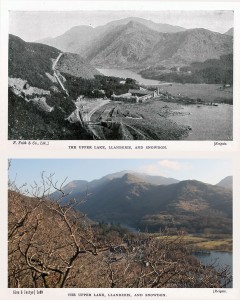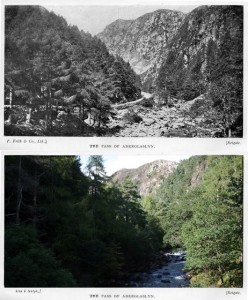With the aid of the beautiful road linking Pen-Y-Gwryd and Beddgelert, the two highways running south-eastward from Caernarfon encircle the mountain mass collectively know as Snowdon. The more easterly road from Caernarfon is accompanied by the railway as far as Llanberis.
By Llanberis is meant the modern village of that name. It contains the railway station and is a good two miles from the old village. It is a common centre of the motor routes from the Betws y Coed, Bangor, Caernarfon and Beddgelert, and the quarter chosen by the great majority of tourists who make the ascent of Snowdon, the Glyders, the Elidyrs, and Moel Eilio. The village is situated on the western side of Llyn Padarn, a lake two miles in length. The lake is connected with Llyn Peris by the river Seiont. Boating can be enjoyed on both lakes, and the lakes and rivers alike afford sport for the angler. At the northen end of Llyn padarn is a picturesque stone bridge leading to a Roman camp at Dinas Dinorwic, about a mile off.
A feature of Llanberis often overlooked is the Ceunant Mawr (the ‘big ravine’) with its waterfall, well worth a visit after heavy rain, though less effective in the dry weather. The fall is about 5 minutes’ walk south of the village, up the lane on the right just after crossing the stream as one walks from the station.
At Llanberis begins the ascent of the magnificent Pass of Llanberis.
Llanberis nowadays doesn’t have a train station, but it does indeed have the World best cafe – Pete’s Eat, and by itself is worth a visit! I love how we managed to pin point exactly the first shot here, it was an epic journey, with beautiful views, sunshine, and sunglasses.



